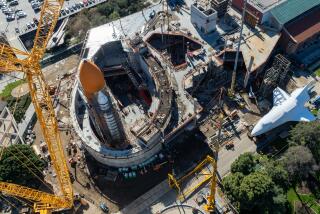Endeavour Crew Tests Flight Path of Wobbling, Lopsided Satellite
- Share via
KENNEDY SPACE CENTER, Fla. — Endeavour’s astronauts released a lopsided satellite Wednesday to test whether small spacecraft can fly straight using only their weight and Earth’s magnetic field, rather than steering jets.
Crewman Mario Runco Jr. pushed the button that caused the 80-pound aluminum satellite to pop out of the space shuttle. It spun and wobbled as it drifted away, just as researchers expected.
The astronauts shot lasers at the satellite to measure its wobble. But the wrong sides of the satellite, the sides without laser reflectors, always seemed to be facing the shuttle, hampering the crew’s efforts.
NASA mission manager Neal Barthelme said it probably will take a few days for the satellite to stabilize and for one of its reflective ends to point toward Endeavour.
The satellite, 14 inches in diameter and 20 inches long, is weighted at one end like a dart or badminton shuttlecock and is equipped with magnetic rods. Researchers hope this combination of mass and magnetics will keep the satellite positioned correctly--that is, with the heavy end pointed in the direction of travel.
If successful, the $600,000 experiment could pave the way toward small spacecraft that can be launched without expensive thrusters and fuel tanks.
“This is a great process in the cheaper, faster, better mode that NASA’s working in the 90s,” Barthelme said.
Endeavour and its crew stayed at least 2,000 feet from the satellite, as the two craft circled Earth at 17,500 mph.
More to Read
Sign up for Essential California
The most important California stories and recommendations in your inbox every morning.
You may occasionally receive promotional content from the Los Angeles Times.













